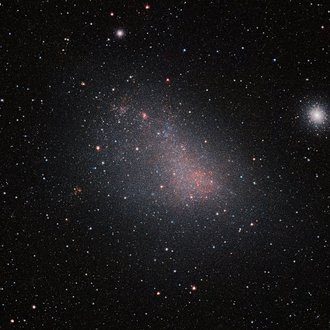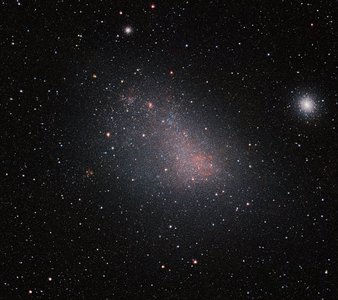Peeking Through the Cloud’s Dusty Veil

The whole frame of this VISTA image is filled with stars belonging to the Small Magellanic Cloud. It also includes thousands of background galaxies and several bright star clusters, including 47 Tucanae at the right of the picture, which lies much closer to the Earth than the SMC. The wealth of new information in this 1.6 gigapixel image (43 223 x 38 236 pixels) has been analysed by VMC team member Stefano Rubele of the University of Padova.
Credit: ESO/VISTA VMCThe biggest infrared image ever taken of the Small Magellanic Cloud: With the telescope VISTA, an international team of astronomers led by AIP researcher Prof. Dr. Maria-Rosa Cioni has been able to see the myriad of stars in this neighbouring galaxy much more clearly than ever before.
The Small Magellanic Cloud (SMC) galaxy is a striking feature of the southern sky even to the unaided eye. The SMC is a dwarf galaxy, the more petite twin of the Large Magellanic Cloud (LMC). They are two of our closest galaxy neighbours in space — the SMC lies about 200 000 light-years away, just a twelfth of the distance to the more famous Andromeda Galaxy.
Their relative proximity to Earth makes the Magellanic Clouds ideal candidates for studying how stars form and evolve. However, one of the major obstacles to obtaining clear observations of star formation in galaxies is interstellar dust. Enormous clouds of these tiny grains scatter and absorb some of the radiation emitted from the stars — especially visible light. Infrared radiation passes through interstellar dust much more easily than visible light. VISTA’s infrared observations have now allowed a clear view of what is in the galaxy.
VISTA, the Visible and Infrared Survey Telescope of the European Southern Observatory (ESO) located at the Paranal Observatory in Chile, was designed to image infrared radiation. The VISTA Survey of the Magellanic Clouds (VMC) is focused on mapping the star formation history of the SMC and LMC, as well as mapping their three-dimensional structures. Millions of SMC stars have been imaged in the infrared thanks to the VMC, providing an unparalleled view. “The data obtained by VISTA have outshined our expectations,” says Maria-Rosa Cioni. “At AIP, we measured tiny motions of stars we thought would have not been possible from the ground, and this is just one aspect of the breadth of research enabled by VMC described in over 24 articles to date.”
The VMC has revealed that most of the stars within the SMC formed far more recently than those in larger neighbouring galaxies. This early result from the survey is just a taster of the new discoveries still to come, as the survey continues to fill in blind spots in our maps of the Magellanic Clouds.
Further information
The full press release, more information, images and videos are published on the ESO website: https://www.eso.org/public/unitedkingdom/news/eso1714/
Science contact: Prof. Dr. Maria-Rosa Cioni, +49 331-7499 651, mcioni@aip.de
Publication presenting the research: Stefano Rubele, Léo Girardi, Leandro Kerber, Maria-Rosa L. Cioni, Andrés E. Piatti, Simone Zaggia, Kenji Bekki, Alessandro Bressan, Gisella Clementini, Richard de Grijs, Jim P. Emerson, Martin A. T. Groenewegen, Valentin D. Ivanov, Marcella Marconi, Paola Marigo, Maria-Ida Moretti, Vincenzo Ripepi, Smitha Subramanian, Benjamin L. Tatton and Jacco Th. van Loon. „The VMC survey – XIV. First results on the look-back time star formation rate tomography of the Small Magellanic Cloud”, MNRAS 449, 639–661 (2015).
Images
The whole frame of this VISTA image is filled with stars belonging to the Small Magellanic Cloud. It also includes thousands of background galaxies and several bright star clusters, including 47 Tucanae at the right of the picture, which lies much closer to the Earth than the SMC. The wealth of new information in this 1.6 gigapixel image (43 223 x 38 236 pixels) has been analysed by VMC team member Stefano Rubele of the University of Padova.
Big screen size [1000 x 885, 260 KB]
Original size [1280 x 1133, 470 KB]



